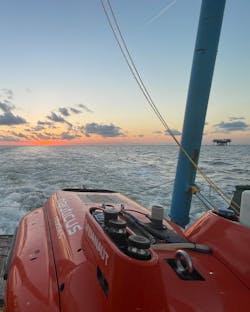Autonomous robots use AI for data collection and intervention services
Editor's note: This story first appeared in the May-June 2023 issue of Offshore magazine as part of the Remote Inspections & Operations Special Report.
By Dr. JD Yamokoski, Nauticus Robotics
The ocean covers 71% of the Earth’s surface and intersects nearly all daily activities, such as food, energy and transportation. It is a $3 trillion economy that few people think about, much less consider its impact on daily lives and the future.
Legacy practices in the offshore industry have remained largely unchanged since their inception more than 50 years ago. This inertia has resulted in widespread operational inefficiencies, industry stagnation and climate degradation. Artificial intelligence (AI) has the power to radically change that reality by streamlining operations, enhancing productivity, and protecting not only human crews but the future of the ocean environment itself.
Nauticus Robotics, a developer of autonomous robots using AI for data collection and intervention services for the ocean economies, believes AI’s benefits in offshore work has potential to continue disrupting an antiquated industry for the betterment of the oceans.
Advancing subsea work
Historically, subsea work involved a ship steaming out and dropping a heavy ROV in the water connected by thousands of feet of cumbersome umbilical back to the ship. This expensive, manual technique has gone largely untouched for decades, while topside the robotics revolution has been exploding.
Nauticus leverages and develops approaches to support subsea applications, with a specific focus on enabling operator-supervised, autonomous inspection and manipulation tasks. These advancements start with a software-enabled solution called Nauticus’ toolKITT, which utilizes AI and machine learning to power autonomous, surface and untethered subsea robotic platforms. It serves as the “mind” for robotic vessels, unifying all of Nauticus’ products into a single control architecture to enable advanced subsea work.
toolKITT is predicated on the vehicle’s ability to make decisions about the environment from onboard sensors. It is self-improving, meaning its ability to solve problems and complete tasks becomes more efficient and precise over time. Therefore, AI-powered robots can substantially improve the outlook of offshore operations compared to legacy methods.
Reducing emissions
AI plays a crucial role in streamlining offshore activities, which improves operational efficiencies and lowers costs as well as drastically minimizes environmental impact.
Common legacy solutions require up to $100,000 per day or more to operate and often need large crews to do so, yet they’re riddled with operational inefficiencies. In contrast, software-enabled solutions like toolKITT, when paired with intelligent all-electric robots, have the power to integrate seamlessly into workflows to accomplish more with less. A single pair of intelligent robots can perform complicated subsea tasks autonomously, with more precision and in significantly less time.
Incumbent methods endanger the planet by emitting up to 70 mt of CO2 into the atmosphere daily, which is the equivalent of 5,000 cars on the road. When multiplied by the number of vessels doing work in the ocean, its impact is huge. Nauticus’ AI-powered, all-electric technology can reduce the estimated CO2 footprint of offshore vessels by more than 90% and lower value stream costs by 50%.
Safety
The efficiencies created by AI innovations significantly increase safety. From 2012-2020, the US Bureau of Safety and Environmental Enforcement collected data from 4,474 offshore incidents, resulting in 1,654 injuries and 23 deaths. Autonomous robots allow for a future with significantly less risk involved in completing a job because fewer people will be needed on site.
Conclusion
AI has the potential to create a future where more autonomous and intelligent robots are used to reduce environmental impact and eliminate human exposure to hazards while improving the offshore industry in every way possible. Nauticus is working to make that opportunity a reality.
